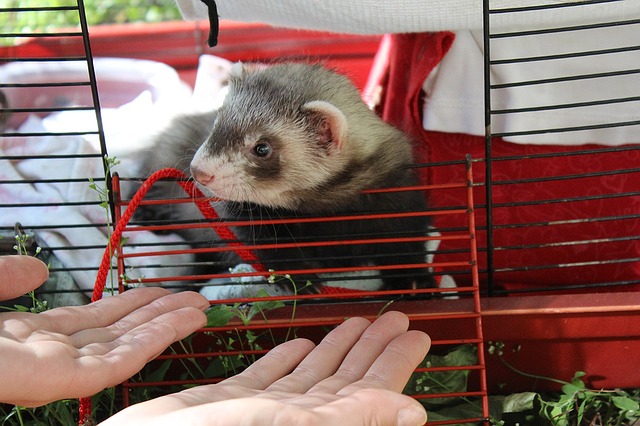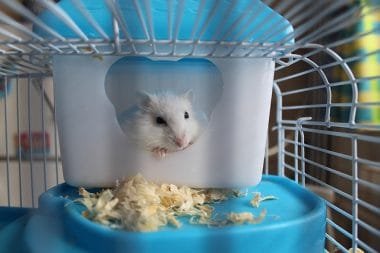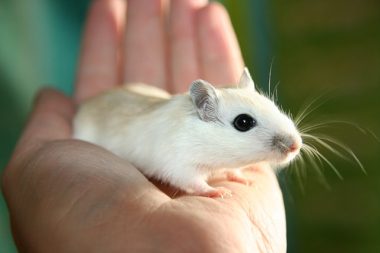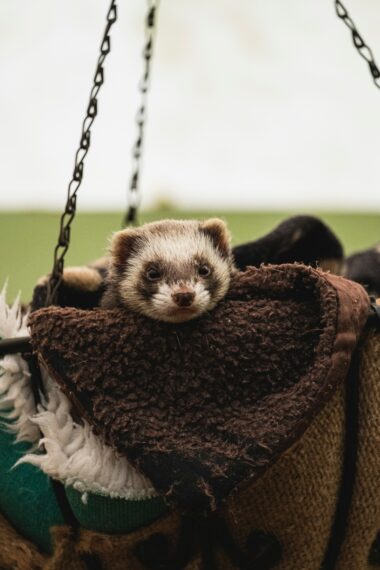Ferrets are interesting household pets. Their care is quite different from that of other common household pets such as dogs, cats, or cavies. It becomes important to learn how to catch a ferret without hurting it, especially if you are a beginner. Due to their unique body structure, you must learn how to catch a ferret properly so that it is a pleasant experience for both you and your ferret.
Ferrets are generally social and enjoy spending time with their human companions. When handled from a young age, they like to be picked up and cuddled, especially after playtime. Their long bodies and flexible bones make catching a ferret an interesting and different experience from holding other pets. Their thin and long bodies require sufficient support so that you avoid harming or hurting your ferret.
Unlike smaller pets such as hamsters, gerbils, or rabbits, ferrets are carnivorous animals. They stalk, hunt, kill and eat other smaller animals. This carnivorous nature makes ferrets prone to attacking anything they perceive as food. Even though your ferret is raised indoors and may not perceive you as food, you should be aware of this habit so that you avoid being bitten.
Ferrets can also be easily frightened or hurt while being held. When in fear of being hurt, they can bite your hands or fingers. Their bite is quite strong. It is important for you to learn how to catch a ferret without hurting it. You will also need to get your ferret used to being picked up and held from a young age. This will calm your ferret and condition it to be handled by humans well.
Ferrets who are handled from a young age will be more open to spending time with humans. They will also enjoy being cuddled and held close to your body. It is important to start holding them when they are young. If you are a first-time ferret parent, then this may seem daunting to you. But with a few key instructions, you will learn how to catch a ferret safely with confidence.
Things to Keep in Mind when Holding a Ferret
Before you learn how to catch a ferret safely, you will need to keep certain things in mind. These tips will help you learn how to catch a ferret safely and make the process enjoyable for both you and your furry pet.
Ferrets Like to be Held after Playtime
Ferrets are carnivorous creatures. They will stalk, hunt and kill their prey which includes small animals and rodents. This carnivorous behavior is best seen during playtime with ferrets. Playtime for ferrets includes a lot of chasing, stalking, and hunting. This exercise is essential for your ferret’s health. It is best to pick up and cuddle ferrets when they have expended all their energy in play. As active and energetic creatures, ferrets prefer to be cuddled after play when they are looking for warmth and comfort. Once they are tired out, you can safely hold and cuddle your ferret.
Carnivorous Instincts
As carnivorous animals, ferrets also have a tendency to attack and bite things they perceive as food. Your fingers and toes are going to become primary prey for your ferrets. This is why it is very important that you wash your hands thoroughly before catching your ferret. Food or other scents on your hands and fingers could trigger your ferret to perceive them as food and launch an attack or bite. This can be quite painful and can affect your relationship with your pet.
Sensitive Backs
Ferrets are long and thin and have a flexible spine. When learning how to catch a ferret safely, ensure that you do not stretch its back. An elongated and stretched-out back or spine is very uncomfortable for your ferret. It could also potentially hurt your furry friend. When holding your ferret, always support its back and hind in such a way that its back is not stretched.
Support the Chest
While ensuring that your ferret’s back does not stretch out, it is also important to support your ferret’s chest. When you catch your ferret, support its chest behind its front legs by placing a hand under its chest. You can also support your ferret by placing your hand around the back of its neck and wrapping your fingers to provide support to its chest.
Use Both Hands
When you learn how to catch a ferret, always use both of your hands to ensure that your ferret is comfortable and safe. Your ferret requires the support of both your hands to feel comfortable and safe because of its elongated body. You may risk stretching out your ferret’s back if you hold your pet only with one hand. This can cause serious pain or discomfort for your furry friend.
How to Catch a Ferret Safely?
The basic rules of how to catch a ferret safely will help you pick up and cuddle your furry friend confidently. Now that you are aware of some of the safety principles, this article will take you through the steps of how to catch a ferret without hurting it. While you can carry your ferret in a bag or hold its scruff, supporting its body with both hands is the easiest, safest, and most comfortable way to catch your ferret.
Wash Your Hands
Before catching your ferret, you must wash your hands thoroughly to get rid of any smells, scents, or odors that may be on your skin. Ferrets have extremely sensitive olfactory systems and they can pick up smells that you otherwise cannot. It’s best to wash your hands thoroughly so that your ferret does not confuse them for food. Unwashed hands will be preyed upon and you may actually end up being bitten.
Hold your Ferret with One Hand under the Chest
When you go to pick up your ferret, you must support its body by placing one hand under its chest. Alternately, you can place your hand on the back of its neck and wrap your fingers around its chest behind the front legs to support its long body. This will support your ferret’s spine and its upper and lower chest. This gives your ferret a sense of comfort and safety. Avoid squeezing your ferret’s body too tightly. Keep your grasp gentle, but firm to prevent your ferret from falling or getting away.
Support the Bottom with the Other Hand
Once you have supported your ferret’s chest, use your other hand to support its back end. Scoop your ferret’s hind legs and butt with your other hand and hold its body close to yours. Your ferret’s back will curl in an S-shape underneath its chest which is supported by your hand. Your hands will now be supporting your ferret’s chest and hind respectively.
Do not become lax about your grasp on your ferret’s body. Ensure that you support both ends of the body during the entire period you are holding your pet. If your grasp becomes loose, you may end up stretching out your ferret’s back and causing discomfort or pain. If your ferret starts to wriggle or gets uncomfortable, hold it close to your body to steady and calm your ferret.
Gentle and Firm Grasp
Ferrets may get frightened or may accidentally get hurt if they slip from your grasp. Ensure that you hold your ferret gently, but firmly. Do not squeeze your ferret’s body too tightly. This may cause your ferret more discomfort and it will try to wriggle and jump out of your hands.
Use both your hands to hold your ferret snugly. Once you have a firm grasp, lift your ferret from the ground. You can hold the ferret close to your body and gently rock it side to side. Some ferrets enjoy this motion and may relax in your arms.
Hold your Ferret Close to your Body
Once you have lifted your ferret, you can hold it close to your body or chest. This will steady and calm your ferret. It will prevent your pet from falling or jumping down and getting hurt. This position is also relaxing for your ferret who will be more receptive to being cuddled during this time.
Be Aware of Your Feelings
Ferrets are extremely sensitive and responsive to your emotions. Be aware of your feelings when you are holding your ferret. If you get excited or emotional when holding your ferret, it will pick up on your emotions and change in demeanor. This will result in a change in your ferret’s behavior too. Ferrets can sense when your pulse or heartbeat quickens or when your grip tightens and may respond with fear or agitation. It’s best to be calm and controlled when holding your ferret and be aware of your surroundings and potential disturbances. This will keep your ferret calm and comfortable. Possible accidents or mishandling will be avoided when you are calm and collected.

What to Avoid when Holding your Ferret?
When learning how to catch a ferret safely, never try to lift your ferret by its scruff alone. You can hurt your ferret and get bitten in the process. If you must hold your ferret by its scruff, place your other hand under its backside to support its hind limbs. Scruffing makes your ferret go limp. This is important when you want to get your ferret checked by the vet, clean its ears, brush its teeth or clean a wound.
Young children should avoid holding and lifting a ferret. They may injure the ferret if they handle them roughly and without supervision. Teach young children how to catch a ferret and interact with it safely. Young children should only interact and play with ferrets at the ground level using treats and pets. Once the ferret is comfortable, it will climb onto your child’s lap to cuddle and have treats.
With their unique and flexible bodies, ferrets need to be handled with care. Their bodies must be supported firmly and snuggly without hurting their backs and skin. It’s always best to catch your ferret with a gentle and firm grasp. When conditioned to being handled at a young age, your ferret will get used to being picked up and cuddled by you. What may come across as daunting at the first go, will come naturally to you. With a few mindful and sensitive attempts, you will soon be holding and cuddling your ferret without worry!








